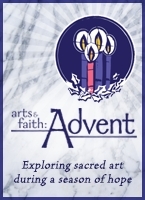Arts & Faith: Week 1 of Advent, Cycle C
Wassily Kandinsky, “The Last Judgment,” 1912

Wassily Kandinsky’s The Last Judgment invites us into the Advent season with an emotional tour de force expressed in color, line, and form. An example of abstract art, The Last Judgment is not narrative or descriptive, but rather expressive. It shows emotion and force and invites the viewer to experience them visually.
The Last Judgement is a composition of bright primary colors, opaque black shapes, and heavy black lines. The lines overlap the colors rather than contain them. Throughout the image, the black lines and the flow of primary colors produce a composition of contrasts.
Although abstract art is generally non-representational, Kandinsky does offer a bridge into his work to help the viewer frame the experience with a narrative clue. On the right center of the image, we see a blue angelic form holding a yellow trumpet. This is an iconic image of the Last Judgment, or the end of days that we hear about in Luke’s Gospel. The angel is a unique element of the painting in which color, form and line converge in a traditional way. The black lines form the boundaries around the colors to give us the silhouette of the angel and the trumpet. An interesting detail about the angel is his wings. One is made of blue color, while the other is entirely made of black lines. Everywhere else in the image, line and color separate, overlap, or even clash. With dual wings, the angel unites within himself the two separate elements of the composition. Recalling Luke chapter 21, we are in a scene that is frightening but redemptive, tumultuous but glorious. We are invited to feel the tension that animates us toward hope.
The Last Judgment is meant to evoke feeling and emotion. The colors of the image, particularly near the center, resemble watercolor and have an ethereal, transcendent, and uplifting quality. The upward flow of the two forms left of center, red and blue as they reach into the bright white center of the image, represent this theme. By contrast, the two solid black shapes near the center have a harshness and heaviness that weighs down and overwhelms the viewer. The overlap of light transcendence and dark heaviness throughout the rest of the image is a visual expression of Luke’s passage and also demonstrates the complexity of the spiritual life.
As Luke reminds us, we are called to prayer and vigilance. We are called to resist that which weighs us down, and make way instead for that which elevates us to stand before the Son of Man.

Commentary is by Daniella Zsupan-Jerome, director of ministerial formation at Saint John's University School of Theology and Seminary.
Related Ignatian reflection on this week’s art
Week 1 of Advent, Cycle C

Advent Resolutions (Ages 11–15)
Recall the tradition of making New Year’s resolutions in preparation for the new calendar year. Observe that the First Sunday of Advent is the beginning of the new Church year. During the season of Advent, our Gospel readings ask us to consider what is most important to us as we prepare for Jesus’ coming, at his birth and at the end of time. Read the Gospel for the First Sunday of Advent, Luke 21:25–28, 34–36. Say: Jesus describes signs that may disturb many people, but he says that these should not disturb his disciples. Why? (because these signs indicate that redemption is near) What does Jesus say that his disciples should do? (Be vigilant and pray for strength.) At this start of the new Church year, consider what “Advent resolutions” you might make to help you stay focused so that you will be prepared to receive the salvation we celebrate at Jesus’ birth and anticipate at Jesus’ second coming. Pray together for God’s help in following through on these resolutions.
Art Studio (Ages 12–15)
Have young people share their reactions to Kandinsky’s The Last Judgment. After a brief discussion, invite the young people to consider how they would depict Jesus’ call for vigilance in Luke 21:25–28, 34–36. Provide art materials of various media (paint, magazines, or colored paper for collages or mosaics, crayons or markers, etc.) for young people to express artistically their own reactions to the Gospel for the First Sunday of Advent.

